Modeling NDVI Using Joint Entropy Method Considering Hydro-Meteorological Driving Factors in the Middle Reaches of Hei River Basin
Abstract
:1. Introduction
2. Methodology
2.1. Trend Analysis
2.2. Joint Entropy and Mutual Information
3. Study Area and Data
4. Results and Discussion
4.1. Variation of Hydrometeorological Variables and NDVI
4.2. Mutual Information of NDVI with Coupling of Variables
4.3. Modelling NDVI
5. Conclusions
- (1)
- The average annual NDVI increased at a rate of 0.005/a over the past 11 years in the middle reaches of the Hei River. The percentage area in which NDVI increased occupied 94% of the total area.
- (2)
- In the desert sub-regions (I and IV), temperature and precipitation are the main driving factors for vegetation growth. In sub-region I, NDVI is consistent with the trend of temperature and precipitation (Figure 9a). However, in sub-region IV, the trend of temperature change is not obvious and the change in NDVI is mainly due to the increase in precipitation (Figure 9b). In the oasis regions (sub-region II and sub-region III), groundwater was an important factor for vegetation growth.
- (3)
- In coupling hydro-meteorological variables, a nested statistical model was proposed for modeling NDVI on a regional scale. The overall correlation coefficient between observed NDVI and modeled NDVI was observed to be 0.97. This high simulation accuracy further proves the suitability of this method.
- (4)
- Due to the influence of human activities, the modeling accuracy was not effective within the artificial oasis (sub-region III and sub-region V). For instance, in irrigation areas, vegetation can absorb water from irrigation to sustain growth but in non-irrigation areas the over-exploitation of groundwater caused by the increase in the amount of irrigation breaks the natural ecological balance, affecting the growth of natural vegetation. Additionally, the shortage of the dataset may also be a factor influencing the modeling accuracy. For instance, the scarcity of temperature and precipitation data may cause nearby cells to have similar values of T and P. Therefore, further studies are necessary for modeling NDVI that consider additional factors such as runoff and irrigation using long-term and higher resolution datasets.
Acknowledgments
Author Contributions
Conflicts of Interest
References
- Kutiel, P.; Cohen, O.; Shoshany, M.; Shub, M. Vegetation establishment on the southern Israeli coastal sand dunes between the years 1965 and 1999. Landsc. Urban Plann. 2004, 67, 141–156. [Google Scholar] [CrossRef]
- Jin, X.M.; Liu, J.T.; Wang, S.T.; Xia, W. Vegetation dynamics and their response to groundwater and climate variables in Qaidam Basin, China. Int. J. Remote Sens. 2016, 37, 710–728. [Google Scholar] [CrossRef]
- Piao, S.L.; Mohammat, A.; Fang, J.Y.; Cai, Q.; Feng, J.M. NDVI-based increase in growth of temperate grasslands and its responses to climate changes in China. Glob. Environ. Chang. 2006, 16, 340–348. [Google Scholar] [CrossRef]
- Dai, S.P.; Zhang, B.; HaiJun, W.J.; Wang, Y.M. Vegetation cover change and the driving factors over northwest China. J. Arid Land 2011, 3, 25–33. [Google Scholar] [CrossRef]
- Liu, J.H.; Wu, J.J.; Wu, Z.T.; Liu, M. Response of NDVI dynamics to precipitation in the Beijing–Tianjin sandstorm source region. Int. J. Remote Sens. 2013, 34, 5331–5350. [Google Scholar] [CrossRef]
- Reed, B.C.; Brown, J.F.; Darrel, V.Z.; Loveland, T.R.; Merchant, J.W.; Ohlen, D.O. Measuring phenological variability from satellite imagery. J. Veg. Sci. 1994, 5, 703–714. [Google Scholar] [CrossRef]
- Clerici, N.; Weissteiner, C.J.; Gerard, F.G. Exploring the Use of MODIS NDVI-Based Phenology Indicators for Classifying Forest General Habitat Categories. Remote Sens. 2012, 4, 1781–1803. [Google Scholar] [CrossRef] [Green Version]
- Feilhauer, H.; He, K.S.; Rocchini, D. Modeling Species Distribution Using Niche-Based Proxies Derived from Composite Bioclimatic Variables and MODISNDVI. Remote Sens. 2012, 4, 2057–2075. [Google Scholar] [CrossRef]
- Rousvel, S.; Armand, N.; Andre, L.; Tengeleng, S. Comparison between vegetation and rainfall of Bioclimatic Ecoregions in Central Africa. Atmosphere 2013, 4, 411–427. [Google Scholar] [CrossRef]
- Xiao, J.F.; Zhou, Y.; Zhang, L. Contribution of natural and human factors to increases in vegetation productivity in China. Ecosphere 2015, 6, 1–20. [Google Scholar] [CrossRef]
- Nemani, R.; White, M.; Thornton, P.; Nishid, K.; Reddy, S.; Jenkins, J.; Running, S. Recent trends in hydrologic balance have enhanced the terrestrial carbon sink in the United States. Geophys. Res. Lett. 2002, 29, 1–4. [Google Scholar] [CrossRef]
- Brunsell, N.A.; Young, C.B. Land surface response to precipitation events using MODIS and NEXRAD data. Int. J. Remote Sens. 2008, 29, 1965–1982. [Google Scholar] [CrossRef]
- Kawabata, A.; Ichii, K.; Yamaguchi, Y. Global monitoring of interannual changes in vegetation activities using NDVI and its relationships to temperature and precipitation. Int. J. Remote Sens. 2001, 22, 1377–1382. [Google Scholar] [CrossRef]
- Pettorelli, N.; Pelletier, F.; Hardenberg, A.; Festa-Bianchet, M.; Cote, S.D. Early onset of vegetation growth vs. rapid green-up, Impacts on juvenile mountain ungulates. Ecology 2007, 88, 381–390. [Google Scholar] [CrossRef] [PubMed]
- Piao, S.L; Nan, H.J.; Huntingford, C.; Ciais, P.; Friedlingstein, P. Evidence for a weakening relationship between interannual temperature variability and northern vegetation activity. Nat. Commun. 2014, 5, 5018. [Google Scholar] [CrossRef] [PubMed] [Green Version]
- Pielke, R.A.; Avissar, R. Interactions between the atmosphere and terrestrial ecosystems, influence on weather and climate. Glob. Chang. Biol. 1998, 4, 461–475. [Google Scholar] [CrossRef]
- Sohoulande, D.C.; Singh, V.P. Retrieving vegetation growth patterns from soil moisture, precipitation and temperature using maximum entropy. Ecol. Model. 2015, 309, 10–21. [Google Scholar] [CrossRef]
- Ichii, K.; Kawabata, A.; Yamaguchi, Y. Global correlation analysis for NDVI and climatic variables and NDVI trends, 1982–1990. Int. J. Remote Sens. 2002, 23, 3873–3878. [Google Scholar] [CrossRef]
- Nicholson, S; Davenport, M. A comparison of the vegetation response to rainfall in the Sahel and East-Africa, using normalized difference vegetation index from NOAA AVHRR. Clim. Chang. 1990, 17, 209–241. [Google Scholar] [CrossRef]
- Jin, X.M.; Guo, R.H.; Zhang, Q.; Zhou, Y.X.; Zhang, D.R.; Yang, Z. Response of vegetation pattern to different landform and water-table depth in Hailiutu River basin, Northwestern China. Environ. Earth Sci. 2014, 71, 4889–4898. [Google Scholar] [CrossRef]
- Lv, J.J.; Wang, X.S.; Zhou, Y.X.; Qian, K.Z.; Wan, L.; Eamus, D.; Tao, Z.P. Groundwater-dependent distribution of vegetation in Hailiutu River catchment, a semi-arid region in China. Ecohydrology 2013, 6, 142–149. [Google Scholar] [CrossRef]
- Jin, X.M.; Schaepman, M.E.; Clevers, J.; Su, Z.B.; Hu, G.C. Groundwater Depth and Vegetation in the Ejina Area, China. Arid Land Res. Manag. 2011, 25, 194–199. [Google Scholar] [CrossRef]
- Mishra, A.K.; Ines, A.V.M.; Singh, V.P.; Asen, J.W. Extraction of information content from stochastic disaggregation and bias corrected downscaled precipitation variables for crop simulation. Stoch. Environ. Res. Risk Assess. 2012, 27, 449–457. [Google Scholar] [CrossRef]
- Singh, V.P. Entropy Theory and Its Application in Environmental and Water Engineering; Wiley: New York, NY, USA, 2013. [Google Scholar]
- Li, C.; Singh, V.P.; Mishra, A.K. Entropy theory-based criterion for hydrometric network evaluation and design, Maximum information minimum redundancy. Water Resour. Res. 2012, 48, 1–15. [Google Scholar] [CrossRef]
- Phillips, S.J.; Anderson, R.P.; Schapire, R.E. Maximum entropy modeling of species geographic distributions. Ecol. Model. 2006, 190, 231–259. [Google Scholar] [CrossRef]
- Pueyo, S.; He, F.; Zillio, T. The maximum entropy formalism and the idiosyncratic theory of biodiversity. Ecol. Lett. 2007, 10, 1017–1028. [Google Scholar] [CrossRef] [PubMed]
- Urbani, F.; Alessandro, P.; Frasca, R.; Biondi, M. Maximum entropy modeling of geographic distributions of the flea beetle species endemic in Italy (Coleoptera, Chrysomelidae, Galerucinae, Alticini). Zoologischer Anzeiger 2015, 258, 99–109. [Google Scholar] [CrossRef]
- Song, Y.; Ma, M. Varition of AVHRR NDVI and its relationship with climate in Chinese arid and cold regions. J. Remote Sens. 2008, 12, 499–505. [Google Scholar]
- Sohoulande Djebou, D.C.; Singh, V.P.; Frauenfeld, O.W. Analysis of watershed topography effects on summer precipitation variability in the southwestern United States. J. Hydrol. 2014, 511, 838–849. [Google Scholar] [CrossRef]
- McGill, W.J. Mutivariate information transmisson. Psychometrica 1954, 19, 97–116. [Google Scholar] [CrossRef]
- Nian, Y.; Li, X.; Zhou, J.; Hu, X. Impact of land use change on water resource allocation in the middle reaches of the Heihe River Basin in northwestern China. J. Arid Land 2013, 6, 273–286. [Google Scholar] [CrossRef]
- Wang, Y.; Roderick, M.L.; Shen, Y.; Sun, F. Attribution of satellite-observed vegetation trends in a hyper-arid region of the Heihe River basin, Western China. Hydrol. Earth Syst. Sci. 2014, 18, 3499–3509. [Google Scholar] [CrossRef]
- Guo, Q.; Feng, Q.; Li, J. Environmental changes after ecological water conveyance in the lower reaches of Heihe River, northwest China. Environ. Geol. 2009, 58, 1387–1396. [Google Scholar] [CrossRef]
- Zhang, A.; Zheng, C.; Wang, S.; Yao, Y. Analysis of streamflow variations in the Heihe River Basin, northwest China, Trends, abrupt changes, driving factors and ecological influences. J. Hydrol. Reg. Stud. 2015, 3, 106–124. [Google Scholar] [CrossRef]
- Qin, D.; Zhao, Z.; Han, L.; Qian, Y. Determinnation of groundwater recharge regim and flowpath in the Lower Heihe River basin in an arid area of Northwest China by using environmental tracers, Implications for vegetation degradation in the Ejina Oasis. Appl. Geochem. 2012, 27, 1133–1145. [Google Scholar] [CrossRef]
- Mi, L.; Xiao, H.; Zhang, J.; Yin, Z.; Shen, Y. Evolution of the groundwater system under the impacts of human activities in middle reaches of Heihe River Basin (Northwest China) from 1985 to 2013. Hydrogeol. J. 2016, 24, 971–986. [Google Scholar] [CrossRef]
- Li, F.; Zhao, W. Changes in normalized difference vegetation index of deserts and dunes with precipitation in the middle Heihe River Basin. Chin. J. Plant Ecol. 2016, 40, 1245–1256. [Google Scholar] [CrossRef]
- Zhou, W.; Wang, Q.; Zhang, C.B.; Li, J. Spatiotemporal variation of grassland vegetation NDVI in the middle and upper reaches of the Hei River and its response to climatic factors. Acta Prataculturae Sin. 2013, 22, 138–147. [Google Scholar]
- Zhao, W.; Chang, X. The effect of hydrologic process changes on NDVI in the desert-oasis ecotone of the Hexi Corridor. Sci. China Earth Sci. 2014, 57, 3107–3117. [Google Scholar] [CrossRef]
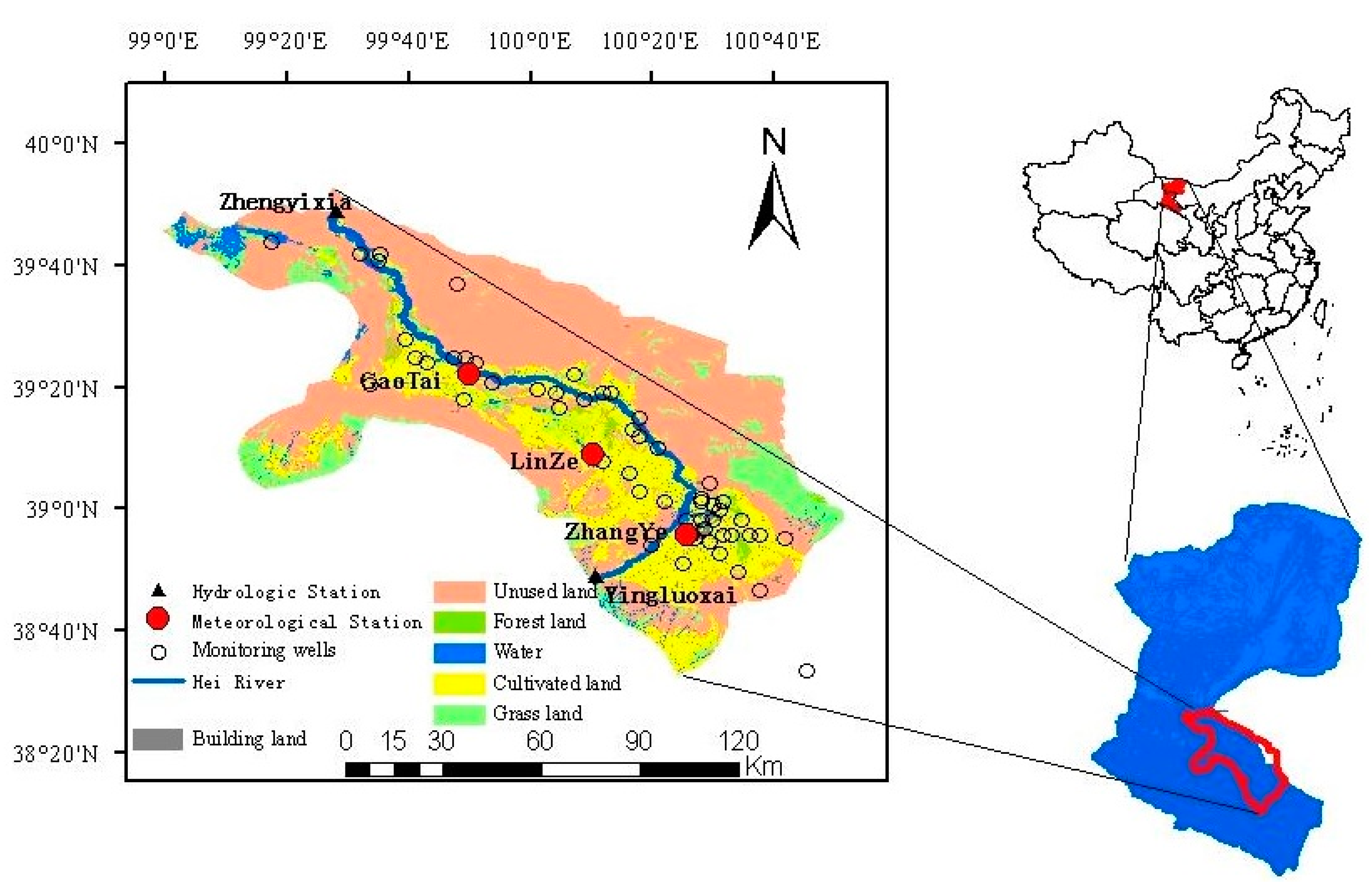
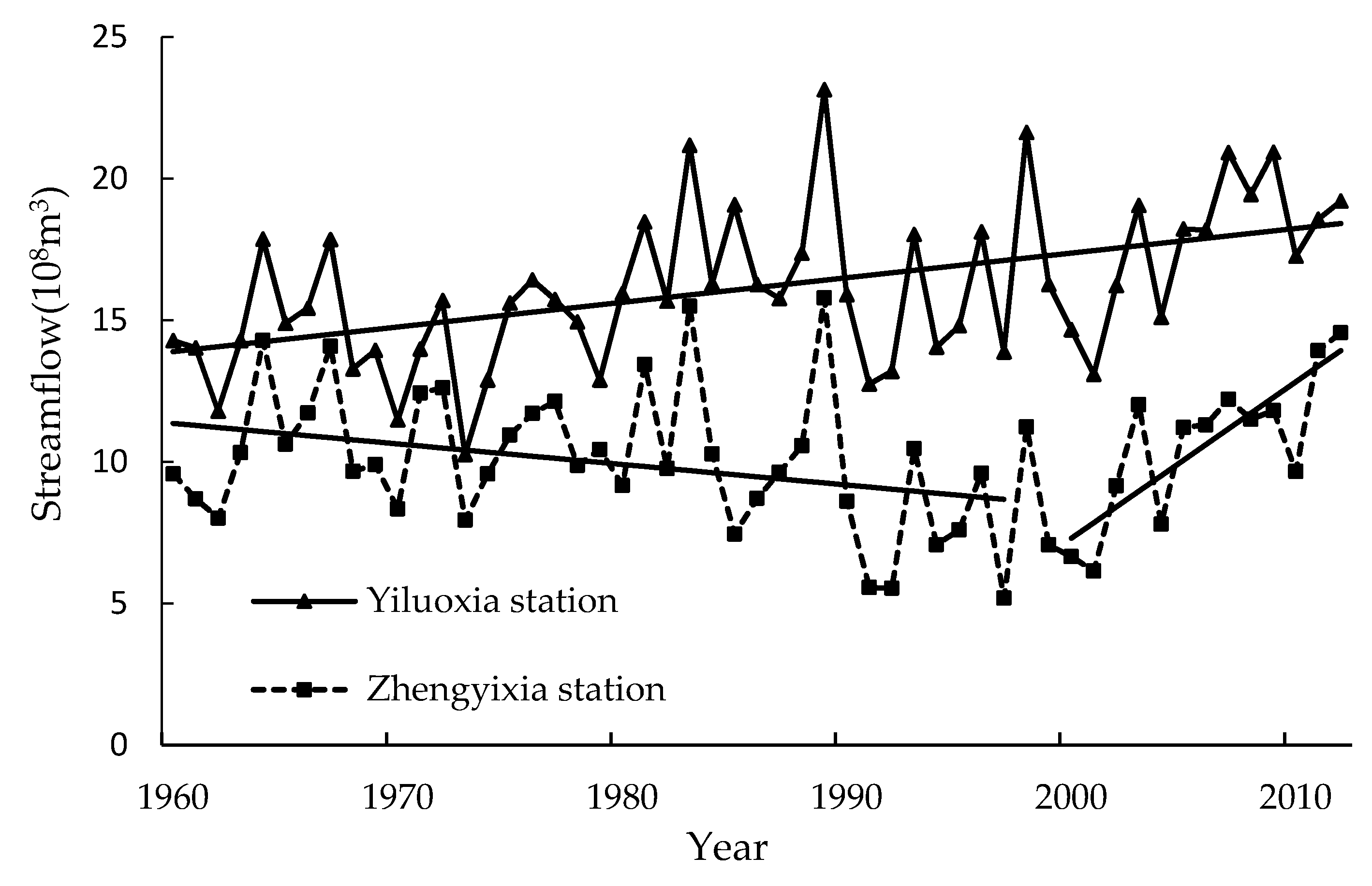
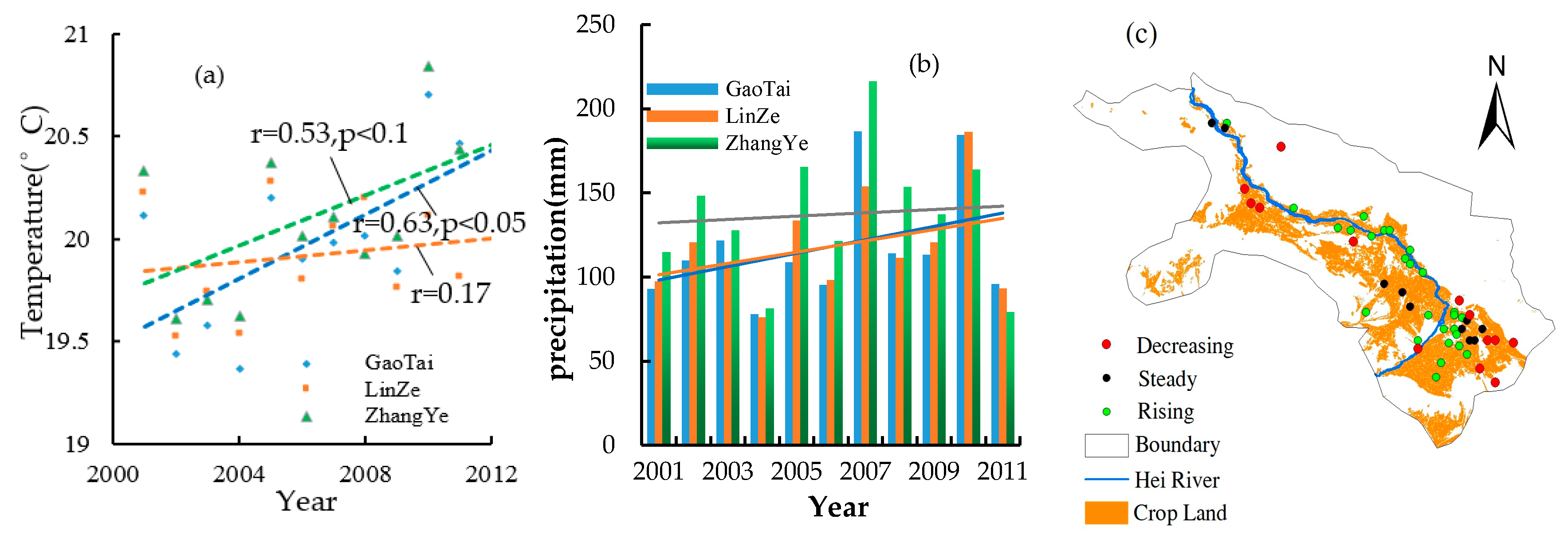
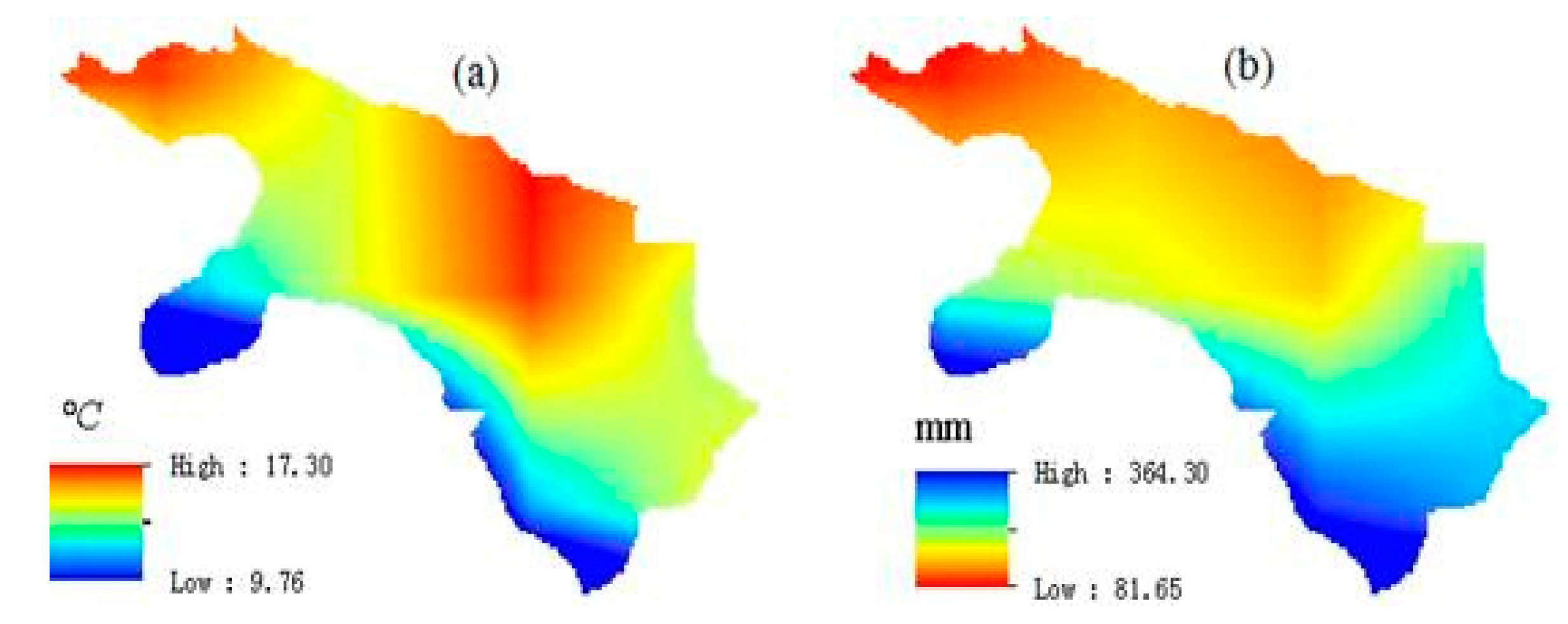
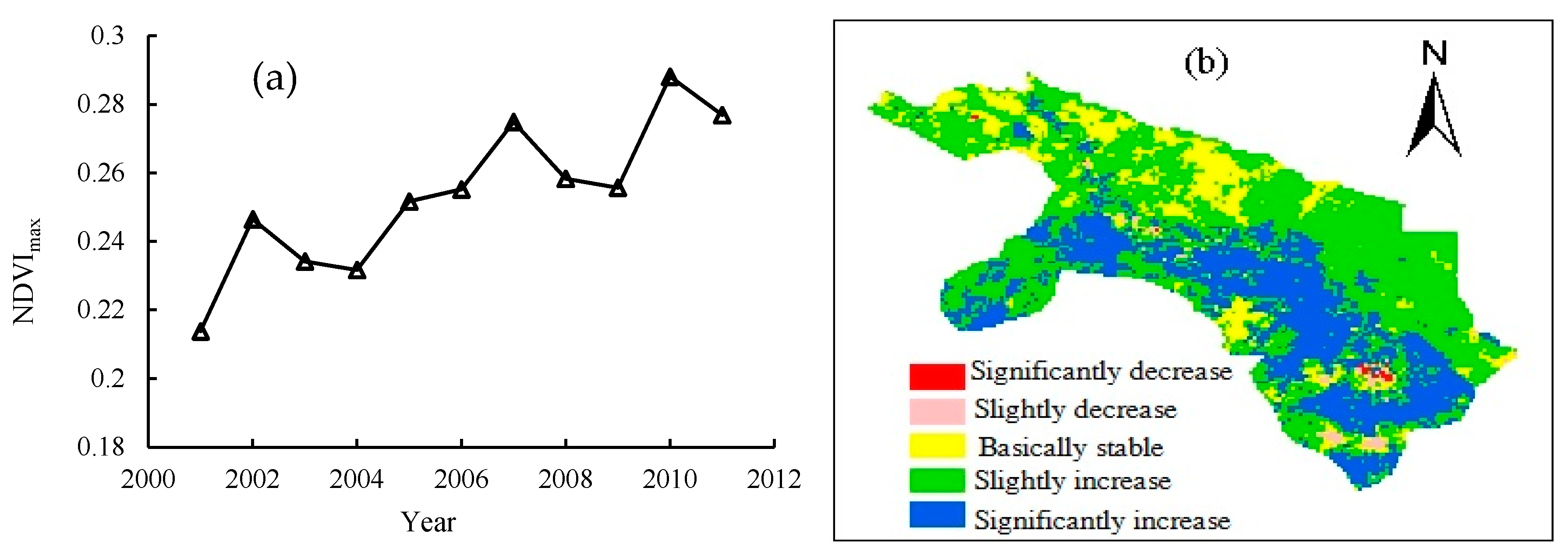
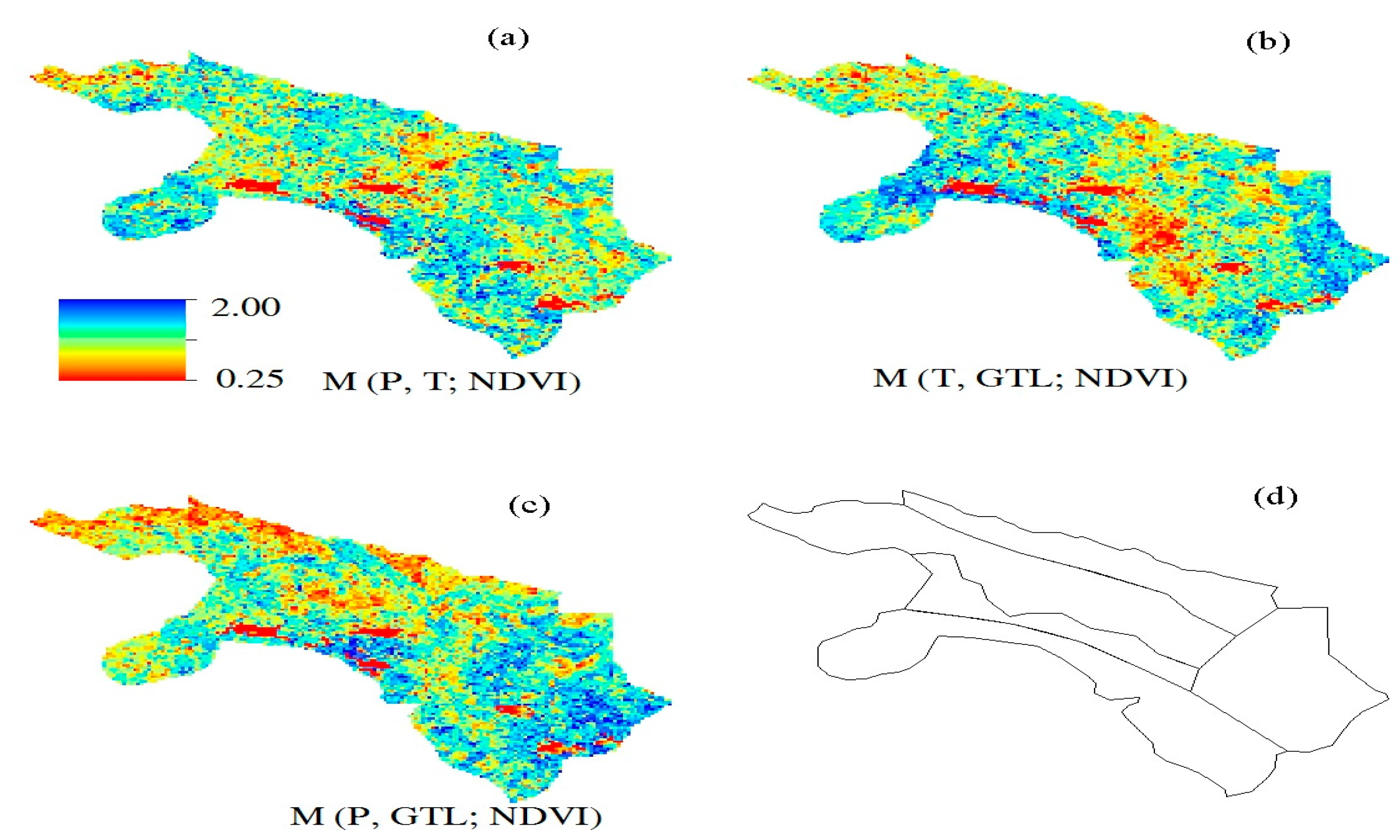
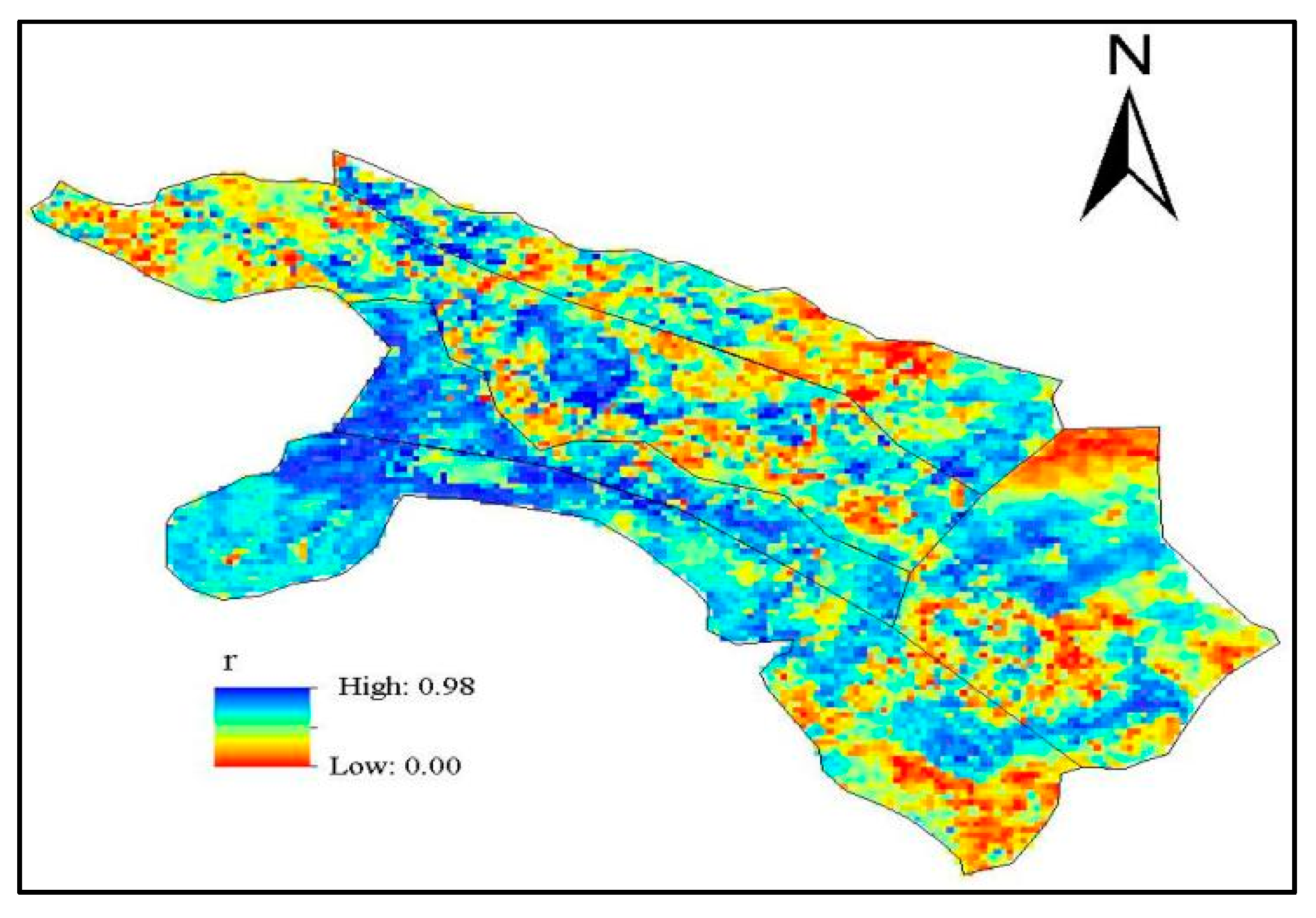

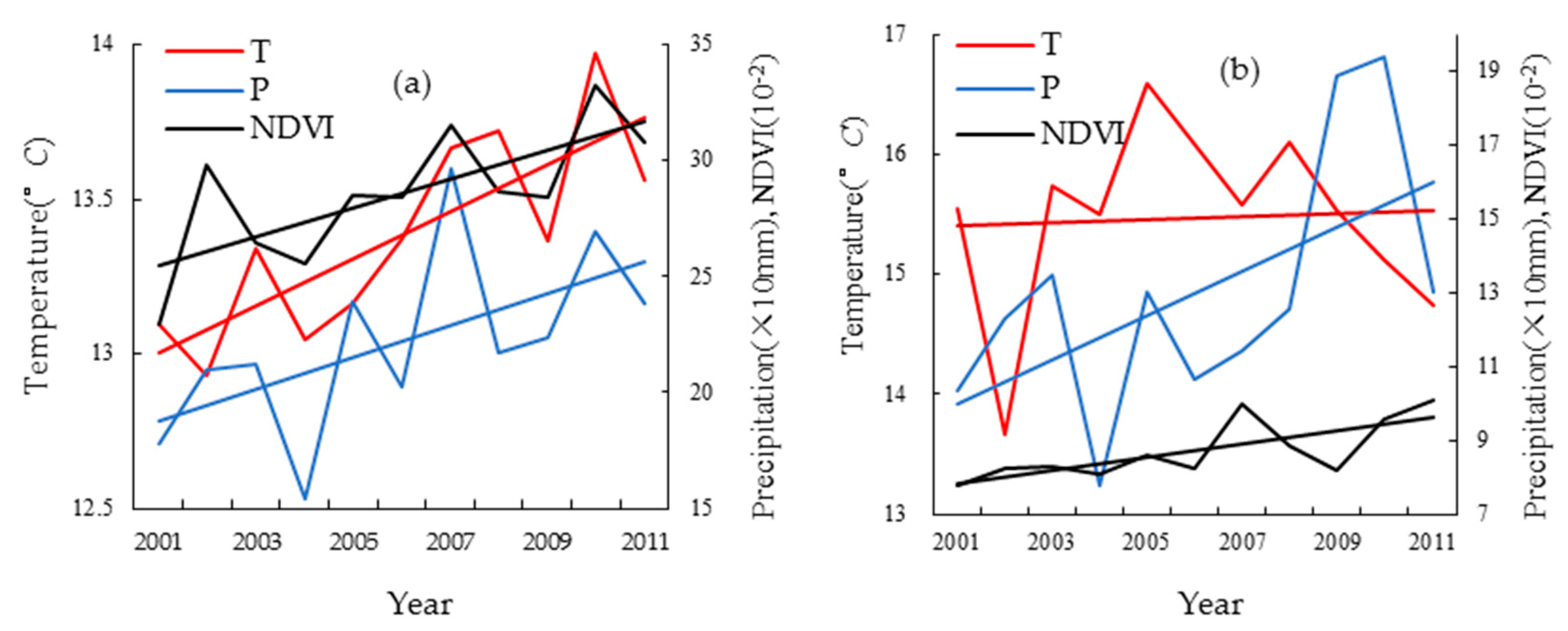
| Variables | Discrete Probabilities | ||
|---|---|---|---|
| X = {X1,X2} | Y = {Y1,Y2} | Z = {Z1,Z2} | |
| X = X1 | Y = Y1 | Z = Z1 | p(X = X1, Y = Y1, Z = Z1) |
| Z = Z2 | p(X = X1, Y = Y1, Z = Z2) | ||
| Y = Y2 | Z = Z1 | p(X = X1, Y = Y2, Z = Z1) | |
| Z = Z2 | p(X = X1, Y = Y2, Z = Z2) | ||
| X = X2 | Y = Y1 | Z = Z1 | p(X = X2, Y = Y1, Z = Z1) |
| Z = Z2 | p(X = X2, Y = Y1, Z = Z2) | ||
| Y = Y2 | Z = Z1 | p(X = X2, Y = Y2, Z = Z1) | |
| Z = Z2 | p(X = X2, Y = Y2, Z = Z2) | ||
| NDVI and Temperature | ||||||
| Region | Region I | Region II | Region III | Region IV | Region V | |
| Function | ||||||
|---|---|---|---|---|---|---|
| liner | −3.6153 | −4.7407 | −6.1732 | |||
| quadratic | −3.8733 | −5.4122 | −6.5508 | |||
| exponent | −0.6537 | −1.3973 | −2.9187 | |||
| logarithm | −3.7049 | −5.2447 | −6.5427 | |||
| NDVI and Groundwater | ||||||
| Region | Region I | Region II | Region III | Region IV | Region V | |
| Function | ||||||
| liner | −1.8812 | −3.8162 | −2.7076 | |||
| quadratic | −3.8876 | −5.1042 | −4.3212 | |||
| exponent | −3.9708 | −2.2641 | −4.3329 | |||
| logarithm | 0.3744 | −5.1401 | 0.4571 | |||
| NDVI and Precipitation | ||||||
| Region | Region I | Region II | Region III | Region IV | Region V | |
| Function | ||||||
| liner | −3.5757 | −1.7001 | −4.9864 | −2.8516 | ||
| quadratic | −4.5808 | −4.714 | −7.1646 | −4.4654 | ||
| exponent | −4.5530 | −4.5093 | −7.1620 | −4.4443 | ||
| logarithm | −4.7402 | −4.7974 | −7.2847 | −2.5677 | ||
| Sub-Region No. | Fitting Formula | Average Correlation Coefficient | Area Proportion | Area Proportion |
|---|---|---|---|---|
| (p < 0.05) | (p < 0.01) | |||
| I | 0.68 | 0.75 | 0.40 | |
| II | 0.66 | 0.72 | 0.42 | |
| III | 0.47 | 0.36 | 0.16 | |
| IV | 0.58 | 0.42 | 0.15 | |
| V | 0.57 | 0.50 | 0.16 |
© 2017 by the authors. Licensee MDPI, Basel, Switzerland. This article is an open access article distributed under the terms and conditions of the Creative Commons Attribution (CC BY) license (http://creativecommons.org/licenses/by/4.0/).
Share and Cite
Zhang, G.; Su, X.; Singh, V.P.; Ayantobo, O.O. Modeling NDVI Using Joint Entropy Method Considering Hydro-Meteorological Driving Factors in the Middle Reaches of Hei River Basin. Entropy 2017, 19, 502. https://doi.org/10.3390/e19090502
Zhang G, Su X, Singh VP, Ayantobo OO. Modeling NDVI Using Joint Entropy Method Considering Hydro-Meteorological Driving Factors in the Middle Reaches of Hei River Basin. Entropy. 2017; 19(9):502. https://doi.org/10.3390/e19090502
Chicago/Turabian StyleZhang, Gengxi, Xiaoling Su, Vijay P. Singh, and Olusola O. Ayantobo. 2017. "Modeling NDVI Using Joint Entropy Method Considering Hydro-Meteorological Driving Factors in the Middle Reaches of Hei River Basin" Entropy 19, no. 9: 502. https://doi.org/10.3390/e19090502




